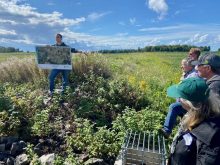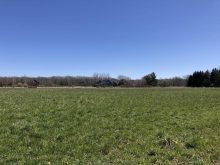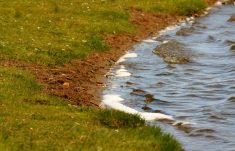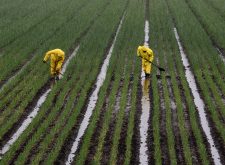Use of an urban-style storm water management system in an agricultural setting is being explored by the Upper Thames River Conservation Authority.
Why it matters: Climate models predict a higher frequency of extreme storm events in the future so exploration is under way on how best to mitigate the effects of such events.
Six plastic, domed underground chambers, surrounded by filter cloth and gravel, were installed this year to take in water from a conventionally tiled, 5.4-acre section of the conservation authority’s 58-acre property.
Read Also

The forced Japanese-Canadian farmers of the Second World War
Manitoba’s sugar beet farms drew on displaced Japanese-Canadians from B.C. during the Second World War
Called a StormTech Stormwater Retention System, it was supplied by project cooperator Advanced Drainage Systems Canada based in Thorndale.
Agricultural stewardship technician Beth Wrona said the system is typically used in urban settings to handle storm water on landscapes dominated by structures and pavement, and is often located beneath parking lots.
“We’re looking at proof-of-concept to see if this might be something that could be used in an agricultural setting.”
The system is set up at the bottom of a sloping field overlooking a stream that empties into the Thames River a few hundred feet away.
Conservation services manager Brad Glasman added that, if the 5.4 acres was entirely covered in impermeable concrete, the hydrologic calculations would call for 91 chambers to handle a projected high-level storm event.
On highly permeable farmland, “there are certainly a few unknowns” and “we took a bit of a flyer on how to design this,” he said. Project designers determined that six StormTech chambers should be appropriate.
Standing nearby is a monitoring station to track flow rates and water quality parameters from the StormTech system. It will also monitor several other drainage-related research installations managed on the farm.
This was a wheat year in the farm’s corn/soy/wheat rotation, with a cover crop of oats, peas and radish established after the 2024 wheat harvest. Notwithstanding the innovative nature of the StormTech project, Wrona said at the outset of a Sept. 5 tour that the highlight is a contoured and controlled drainage installation on 14 acres.
The remainder of the cropped portion of the farm has conventional tile with 30-foot spacing. Glasman said this is basically straight lines to the outlet at the edge of the field to move water as quickly as possible.
With controlled drainage, gates installed inside cylindrical drain access ports can be lowered into the tile at intervals across the field to retain water below the surface. In contoured tiling, tiles follow the contours of the land instead of straight lines leading to the outlet.
A common practice in controlled drainage is one gate for every 18 inches of elevation change. On the Thorndale field, there are 10 control gates in a straight tile running along the edge of the 14 acres being drained, with the contoured tiles emptying into the straight tile along the length of the field.
The authority began work on the controlled/contoured drainage project three years ago, aiming to determine its effects on water peak flow and water quality entering the adjacent stream, compared to conventional drainage.
Full-scale monitoring began this year. Stewardship services coordinator Tatianna Lozier told Farmtario that she’s working to secure four more years of funds to continue monitoring.
Ken McCutcheon from Thorndale-based McCutcheon Farm Drainage, a cooperator on this project, told tour participants that the goal during design and construction was to keep a consistent water level below the ground throughout the field. When they built the contoured aspect of the system, they aimed for a 0.1 per cent slope throughout and McCutcheon estimates they were within six inches of maintaining a constant water level below ground throughout the 14 acres.
For this project, the gates were closed all year except for two weeks before planting and two weeks before harvesting to ensure field conditions were dry for major field activities.
Len Duynisveld farms nearby on Prospect Hill Road, and farms with a similar rotation using strip tillage before corn but no-till practices for all other elements of the rotation.
He installed a single control gate on a systematically tiled 12-acre field at his farm at the same time the conservation authority installed its project. During the summer until this year, the gate has been closed but this year he opened it due to excessive rainfall.
Duynisveld has been happy with the way it performed, and believes there were yield benefits.
A tour participant asked about the financial feasibility of installing controlled drainage structures in an existing conventional tile system. McCutcheon said the Duynisveld farm is an ideal application because it is relatively flat. It wouldn’t likely be worthwhile on sloping or complex ground.
“Cost-wise, the flatter the ground, the cheaper it is to put in,” McCutcheon said.
Also on the conservation authority property are two versions of berms with tile inlets designed to slow overland flow of rainwater off the field. The berms temporarily slow the water so it can flow gradually through the inlet into the tile system.
One has a below-ground inlet with the water flowing through rounded aggregate and a filter cloth before entering the tile. This one can be driven over and an implement simply lifted during cropping activities. The other berm/inlet has an above-ground “Hickenbottom” inlet and must be driven around.
In both cases, Lozier noted, efforts are required to reduce the amount of sediment arriving at the berm, through measures such as minimum tillage and year-long ground cover. Otherwise the berm may need to be removed and replaced.
The berms are designed to allow water to go up and over during extreme storm events rather than rip a trench. The overall goal is to reduce peak flow of surface water leaving the field during a storm event.
The authority aimed for a maximum of 24 hours for water to stand at the berm and on nearby crop. This minimized crop damage and maximized the possibility of sediment settling out before it reached the stream.















